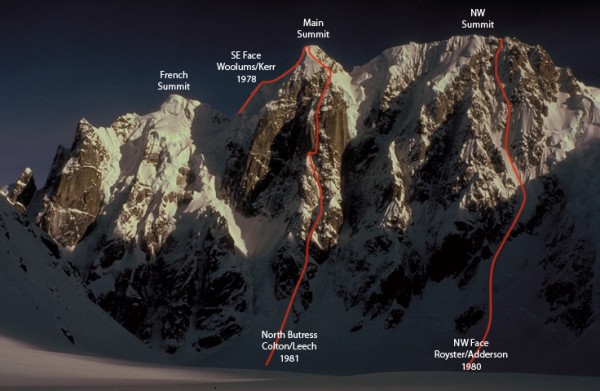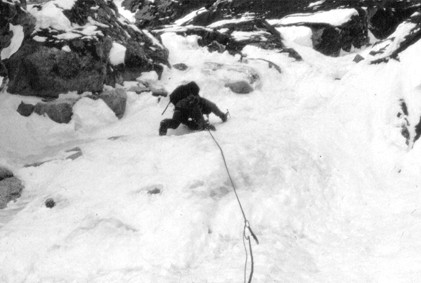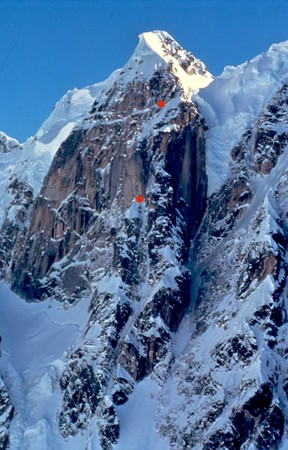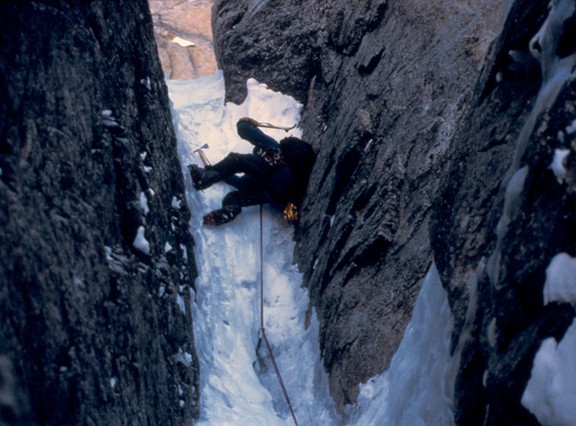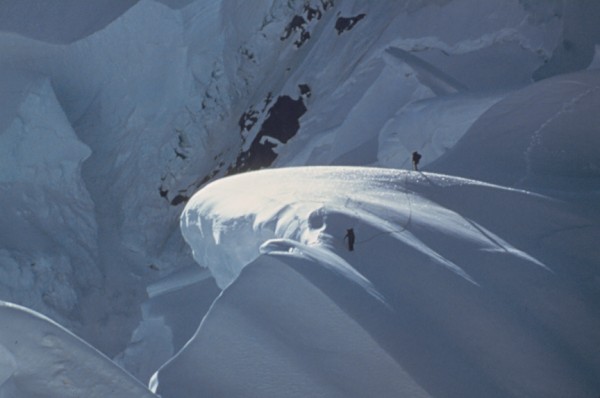OK, so this all happened a long time ago, but someone asked for the story in another thread, so here it is, to the best of my rapidly aging recollection:
In late April 1981, Keith Royster and I had been camped on the West Fork of the Ruth glacier with a couple of friends for two weeks. We were waiting for a weather window long enough for a 3-day alpine style ascent of the unclimbed North Buttress of the Rooster Comb. The pattern had been 2 to 3-day periods of stormy weather separated by a day of clearing. We knew from our experiences of the previous three seasons spent on the Ruth that if we were patient that pattern would reverse, and we could expect a 3 to 4-day period of fine cold conditions.
We both had climbed other Rooster Comb routes on those earlier expeditions. Scott Woolums and I had bagged the first ascent of the Rooster Comb’s main summit in 1978 via the SE Face. In 1979 Jeff Thomas and I made an ascent to the NW summit from the top of the col between the Rooster Comb and Mt. Huntington. In 1980 Keith and Leigh Anderson climbed a new route up the NW Face to the NW summit. Each year we looked at the North Buttress and vowed to come back and give it a shot some day.
That day was rapidly approaching for Keith and I, but the current weather was less than perfect. It WAS good enough for a bush pilot from Talkeetna to land on the West Fork just above our camp and drop off two British climbers, Nick Colton and Tim Leech. They post-holed over to our camp, introduced themselves and announced that they were going to climb our route the next morning.
After the brits left to set up their camp we convened a hasty war council. We could beat them to the base; our gear was packed and we had skis. In a footrace we could move much faster that the post-holing brits and get on the route ahead of them. But we knew the weather, and it wasn’t going to be good. We had seen the lower buttress disappear under enormous avalanches more times than we could count. At best there would be continuous spindrift for most of the route. It was a huge decision… did we want the first ascent or the best ascent? In the end we decided to wait for the weather. We were climbing for fun, we told each other, not glory.
Five days later Nick and Tim were back from their epic. Or maybe it was just a typical day on the crag for them, being crazy brits and all. The constant spindrift had slowed them down dramatically in the lower third of the route, and they had bypassed the crux section of the gully by aid climbing around to the right. If we couldn’t be first, maybe we could score some points on style.
Now finally the weather was becoming settled, and we hoped most of the new snow had fallen off the route, because we were going to go that night. It seemed to us that, after weeks of watching the face over the past three years, the big avalanches cut lose in the mid-afternoon. By starting the climb at 10pm, we could be out of the lower gully before noon. Even in late April there is plenty of light for gully climbing at night.
We blasted off right on time, leaving our skis at the base of the route. The lower gully was classic, with excellent snow and ice up a twisting gully, perfect granite on both sides. We climbed together, moving fast, the leader placing pro until out of gear. Sometime before dawn we switched leads at Nick and Tim’s first bivy platform, set dead center in a wide section of the gully. I was nervous just stopping there to belay. It must have been a nasty bivy in the conditions they were climbing in.
By 10am we were feeling like we were in safer ground, with most of the lower gully below us. About that time our friend Jim Olson was at the base to retrieve our skis. From the center of the West Fork he watched a massive avalanche fall into the gully below us. A cornice had let go from high above and it scoured the gully, then washed out halfway across the West Fork. A half-hour slower and we would have been right in the firing line. As it was, we were blissfully unaware of our close call.
At about the halfway point, the gully becomes discontinuous as it runs into a prominent 500-foot rock band. We set our first bivy where the snow and ice of the lower gully met the rock band. It was a very small platform, maybe two feet wide, but well protected by the overhanging bulge of rock above. We spent the night in sleeping bags and bivy sacs at –20F. I had a miserable night, not cold, but cramping up on the narrow snow ledge. Even my facial muscles were cramping, locking my eyes shut.
About 30 feet right of our platform, the next pitch began with a 30 foot section of vertical rock, beyond which the gully picked up again, though quite a bit more steep than it had been. Keith made quick work of the rock, and led up the gully a ways before bringing me up. I got a really sweet lead up the gully to the base of the crux pitch. This is the point where Nick and Tim had climbed out to the right, bypassing the heinous, rotten vertical ice hose that the gully had just become. I was not unhappy that it was Keith’s lead!
Keith led up some beautiful gully ice to the foot of the overhanging 40-foot chimney partially filled with some really crappy looking ice. He put in an ice screw that MIGHT have held a light fall, and headed straight up. It was mostly a very scary looking stem, with his backpack and right shoulder against the rock wall on the right and his feet kicking holes into the rotten ice curtain on the left. It was a monster effort, and I was sweating bullets for him until he finally pulled over the top. Definitely a no fall situation!
Keith continued on easier vertical mixed ground and banged in a belay. I jugged past the heinous chimney, thinking all the while what a scary lead it must have been. I lead off from Keith’s belay, first traversing left to follow the remnants of the gulley, now degenerated into vertical ice-filled cracks. Protection was scarce, and my first piece after traversing left was a number 1 stopper. I climbed up another twenty feet of ice-covered rock, heading for a three-inch wide runnel of ice. At the base of the runnel I was REALLY looking for a placement, and there in the base of the crack was a fixed pin left by Nick and Tim. I hit it a couple of times with my north wall hammer. It rang true and I and clipped in. WHEW!
I set my axe and north wall hammer into the ice of the runnel and grabbed hold of the sling I had clipped to the fixed pin to lean back for a good look up the ice runnel. Suddenly the rock broke, the pin pulled, and I was forty feet lower, upside down over 2000 feet of air. Hanging from the number 1 stopper, I watched my snow shovel fall back to the glacier. I looked over at Keith as I slowly rotated in the air. He told me, “Stop screwing around Kerr, I’m freezing over here!” I got back on the rock, and looked up to see my ice tools waiting for me, still stuck in the runnel. The pitch had been hard with tools. Climbing back up to them barehanded was “interesting”.
Once reunited with my tools, I banged the pin back in and scampered up the ice. For the first time in two days I climbed into the sun. I anchored in and brought my frozen partner up. In a couple more easy pitches we were above all difficulties and built a commodious bivy ledge.
The next morning we kicked up the summit snowfield and pulled out the flask for a quick summit celebration. The weather was still holding perfect, and we enjoyed the 360-degree view for a few minutes before starting down the ridge that led to the col between the main summit and the NW summit and plateau. The descent to the col was exciting ridge climbing, ending in a long free rappel into the col. The climb up to the NW summit ridge was not difficult and we walked west across the plateau to the top of the wide gully that leads down to the Huntington/Rooster Comb col. It was late and we decided to bivy in the bergschrund before descending to the col.
Unfortunately, we were out of food. After we dug our way down into the crevasse and set up our bivy, I told Keith I was going out to find us some dinner. He looked at me like I had been smoking too much pot. I crawled out of our cave and crossed the top of the descent gully to the base of a large rock. I dug at the snow and rock for a few minutes, then reached into a hole in the rock and retrieved the bag of food and fuel that Jeff Thomas and I had left there the year before. Keith was suitably impressed with our foresight when I returned with a huge meal for two and a pint of stove fuel.
We started down early the next morning, and made two rappels down the gulley. We were crossing the giant cornices of the col barely an hour after we started down, working our way across to the west side, and the safest descent route to the West Fork. I knew the way down from the Huntington/Rooster Comb col really well. I’d made two round trips over the col in 1979 on our way to Mt. Huntington’s SE side, and one round trip in 1980 to gain the East Ridge of Mt. Huntington. It’s straightforward snow and ice climbing, made a game of terrifying Russian roulette by the huge cornices and seracs that threaten every part of the face. This is definitely not a place to stop for a picnic, and Keith and I fairly flew down the face, reaching the glacier in about two and a half hours.
We felt great after the climb. We had managed to cut a full day off the first ascent time, climbed the crux gulley pitch, and done it in a spell of perfect weather. The North Buttress is the most classic line in the West Fork, in my book, and I put it at the top of my personal list of achievements.
Some days after we got back to base camp, Nick and Tim returned from climbing a new route on the West face of Mt. Huntington. You had to hand it to those two; they really maxed out the possibilities on their visit to the West Fork. Two years later Keith and I skied back into the range from the North, destination: the Colton/Leech route on Mt. Huntington. But that is another story…
